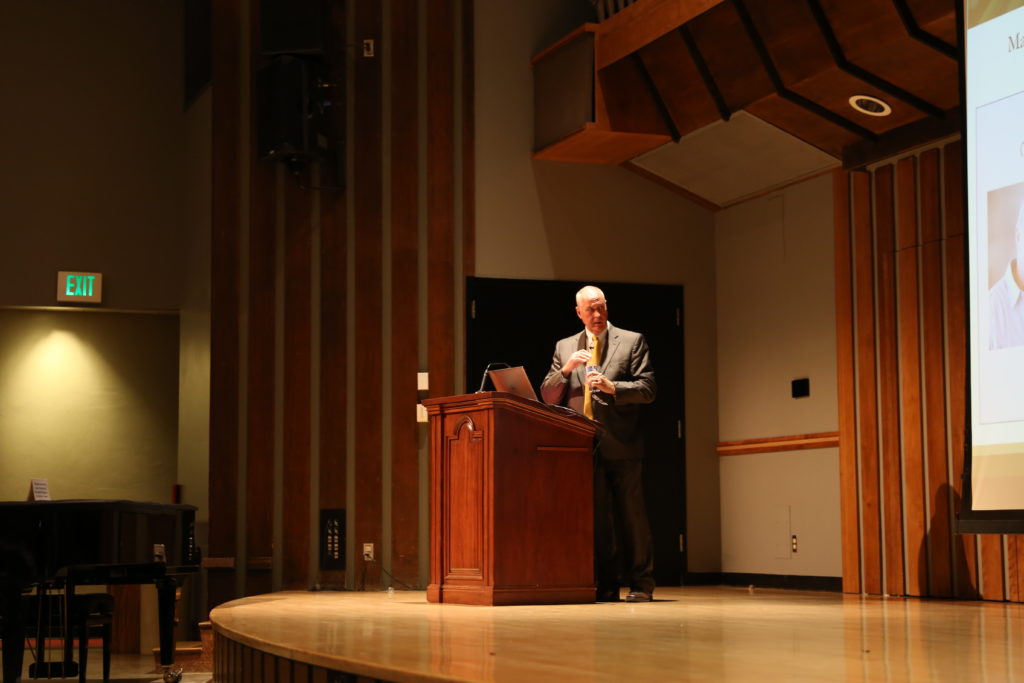
Scott M. Peterson, the founder and investment advisor for Peterson Wealth Advisors, advised men and women on how to make the most out of their charitable giving in an Education Week presentation titled, “How the New Tax Law Impacts the Way That You Will Make Charitable Contributions” on Aug. 20.
Peterson opened the class by noting it’s not necessarily how much is donated, but rather the process by which the gift is given that is the most important factor.
“Sometimes it’s not how much is given, it’s how the charitable gift is given that determines the tax savings,” Peterson said.
Utah is among the top five happiest states and is ranked first in financial stability and ninth in overall well being, according to Peterson. Utah is also ranked the most charitable state in the union and the third highest in donations.
Peterson said as taxes are minimized through the use of tax-efficient gifting strategies, the capacity to be more charitable increases. He mentioned four strategies and talking points for one to share with his or her tax professional.
Strategy #1: Donating appreciated assets to charity
Peterson said attendees should make charitable donations using appreciated assets whenever possible. Historically, tithing was paid in kind using eggs, milk or other agriculture products. Even today, the church still accepts donations in kind. Instead of receiving agricultural products as in days past, charities now receive shares of stocks, mutual funds and Exchange Traded Funds (ETFs). Almost every charity, including the church, knows how to accept donations in kind. Peterson used an example of a family that owns stock to demonstrate how the strategy works.
The Smiths own $25,000 in Apple stock that consists of mostly gains, which if they sold the stock, they would have to pay taxes on the gains. If they sell the stock, the value would be reduced by $5,000 due to state/federal tax. But, if they want to donate the stock, no taxes would be due.
By donating the stocks to charity, the charity gets an additional $5,000, and the Smiths won’t have to pay any tax on the stock’s gain. Additionally, the donor can deduct $25,000 from their taxes as a charitable contribution versus $20,0000 and can use the cash they otherwise would have paid to in taxes to buy a more diversified portfolio of stocks.
Peterson then went on to discuss how tax laws changed in 2018.
In 2018, the standard deduction was almost doubled and some itemized deductions have been reduced or eliminated. Because of this, it’s estimated that only 5 percent of Americans will be itemizing their tax deductions in the future. For the 95 percent of Americans that take the standard deduction, writing a check to a charity will have no impact on their taxable income.
Strategy #2: Maximize your deductions by “bunching”
Peterson asked class members to consider a strategy of bunching deductions to maximize overall tax deductions. For this strategy to work, one would need to bunch as many of their itemized deductions as possible into a single year.
For this strategy, Peterson discussed a couple named Mike and Carol as an example. If Mike and Carol were to bunch three years of charitable contributions into one year, they could save several thousand dollars in taxes annually.
Strategy #3: Consider the benefits of using a Donor-Advised Fund

Peterson also recommended using a donor-advised fund. Donor-advised funds are charities that hold someone’s money until they decide where to donate. By making larger, multi-year charitable contributions in a single year, one could get the tax deduction in the year it would be most beneficial to the donor, and then transfer money from their donor-advised funds to their favorite charity in future years.
Using this strategy, bunching deductions becomes easier and charitable giving becomes more flexible and easier to accomplish. Peterson said those donating can also receive tax deductions when they are most needed.
Peterson also noted many people don’t itemize their deductions and end up taking the standard deduction. However, without itemizing, charitable donations will not reduce a larger tax burden.
Strategy #4: The use of the Qualified Charitable Distributions
Peterson also recommended attendees investigate whether or not qualified charitable distributions makes sense in their financial situations. A QCD is only for those ages 70.5 and up and allows a withdrawal from one’s individual retirement account to be tax-free as long as the withdrawal is transferred directly to a qualified charity.
Peterson gave an example of an elderly couple to illustrate this point. Michael, 72, and Megan, 71, make charitable donations of $7,000. The couple takes the standard deduction because they don’t have enough deductions to itemize, and therefore won’t receive a tax benefit for mamking their $7,000 donation to charity.
Alternatively, if they used a qualified charitable distribution and transferred $7,000 to their charity instead of writing a check, their tax liability would be reduced by more than $1,000. Peterson referred back to the beginning of the class by stating, “It’s not how much they gave, but how they gave that makes the difference in many situations.”
QCDs can also be beneficial to those who do itemize their tax deductions. In almost every instance, those who give to charity and simultaneously make distributions from an IRA can benefit from doing a QCD, Peterson said.
He ended his presentation by quoting Elder Jeffrey R. Holland, who said: “I don’t know exactly how each of you should fulfill your obligation to those who do not or cannot always help themselves. But I know that God knows, and He will help you and guide you in compassionate acts of discipleship if you are conscientiously wanting and praying and looking for ways to keep a commandment He has given us again and again.”




